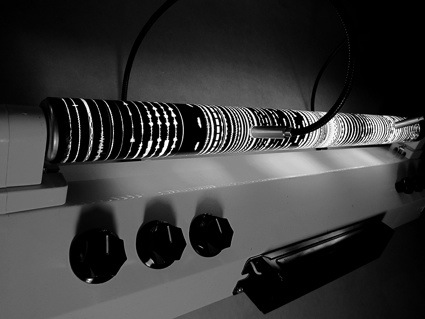 Arcangel Constantini, Phonotube
Arcangel Constantini, Phonotube
In 1880 Alexander Graham Bell Invented the Photophone. While his earlier invention, the telephone, uses electricity to transmit voice communications, the photophone relied on a beam of light to send sound. A person’s voice was projected through an instrument toward a mirror. The vibrations of the voice caused vibrations in the mirror. Sunlight was then directed into the mirror, where the vibrations were captured and projected back to the photophone’s receiver where they were converted back into sound.
Bell believed that the photophone was “the greatest invention [I have] ever made, greater than the telephone”. He might be right, the photophone was a precursor to the fiber-optic communication systems. The reason why the photophone didn’t take off during Bell’s time is simply that the system was useless whenever the weather was cloudy.
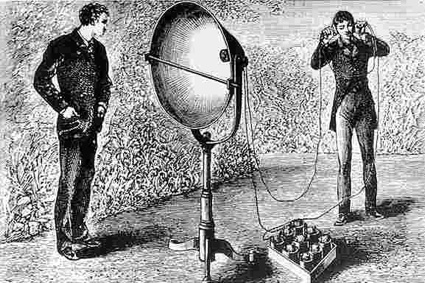 A photophone receiver and headset, one half of Bell and Tainter’s optical telecommunication system of 1880 (photo)
A photophone receiver and headset, one half of Bell and Tainter’s optical telecommunication system of 1880 (photo)
Inspired by Bell’s patent for the photophone, artist Arcangel Constantini developed the Phonotube which uses fluorescent tubes and strips of leds as light instruments and sound sequencers for audio and visual performances.
The tubes are covered with negative offset, printed with sound patterns that spin at variable speeds. The oscillation from the light emitted by these patterns is transduced into sound processes by light excitation, through a variety of electronic circuits as pre-amps photo-cells and photodiodes, voltage control oscillators, relays, circuit Filters, 1bit systems.
The Phonotube is part of the program of the Sight + Sound festival which will take place in Montreal next month. And because i’ve been admiring Arcangel’s work from afar on too many occasions, i thought i should take the upcoming festival as an excuse to get in touch and interview him about the work.
Phonotube Live : Calit2 auditorium UCSD ” three junctures of remix” 2013
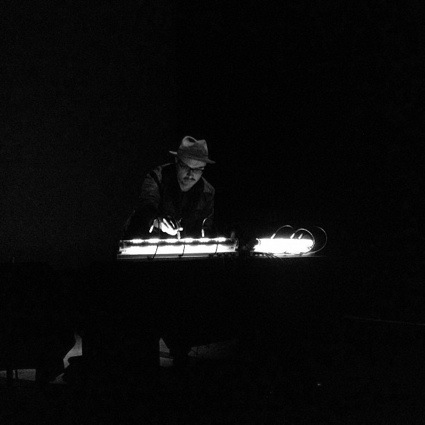 Phonotube Live : Calit2 auditorium UCSD ” three junctures of remix” 2013
Phonotube Live : Calit2 auditorium UCSD ” three junctures of remix” 2013
Hola Arcangel! Reading through the description of the Phonotube on your website, i had the felling (perhaps wrong) that it relies on a fairly simple technology. Is that correct? How much did you have to tweak.improve/modify the Graham Bell patent for the Photophone?
In reality, it is a very simple technology, the patent is very crude, clever and significant. It is about the transmission of information using vibrating light, Graham Bell state that this was his legacy to human kind and this is true.
We perceive our surroundings because of light oscillations, our retina transmits the perception of the visible spectrum of light to the part of the brain that interpret this light frequencies as images.
Every aspect of reality is on its own frequency, mystics knew this by meditation and contemplation, science by theory and experimentation, all this intermingling knowledge is a legacy, Graham Bell had an intuition on how to manipulate light to integrate information on it, and with this started a revolution. I’m interested in researching this simple perception principles through art practice, in exploring the meanings and implications while experimenting with the process.
Phonotube is part of this research, based on a simple principle, in this case experimenting with fluorescent lights. To energize this kind of lamps, a transformer and electronic circuit are used to generate high voltage in a high frequency energy, the gas inside the lamp is expelled and turns into a light that is vibrating to this energy frequencies. The light produced is a kind of carrier, the repetitive patterns printed in the tube give a new oscillation to this light, small Photocells are transforming light into electrons, this energy is pre-amplified to audible sound, and processed trough filters. Furthermore, a circuit with Photo diodes is used as a variable for Low Fidelity Voltage Controlled Oscillators.
A second sound artifact uses a strip of LED lights inside a transparent Tube. A series of AtTiny85 microcontrollers are programed in 1 bit sound (1, 0) that produce light pulsations on each of these LEDS. Small photocells and a pre-amplifier Circuit transform these pulsations into audible sound. OculO is another instrument involved in the performance, it uses a Joule thief hack from a disposable camera that energizes a 22 watt circular lamp with a 1.5 volt battery. Photocells transform the gaseous light into sound. These energy frequencies and the electromagnetic induction become part of the sound performance of OculO. I also interact directly with my body, canalizing energy by receiving tiny electroshocks in my fingers trough contact with the electrodes and the lamps.
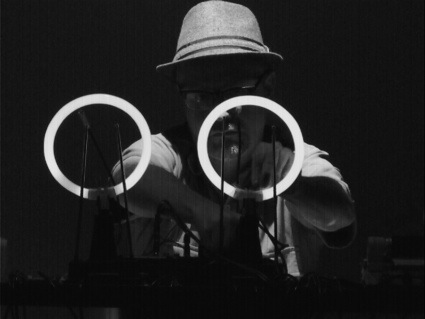 Phonotube & OculO Live : –>Metting PointOculO
Phonotube & OculO Live : –>Metting PointOculO
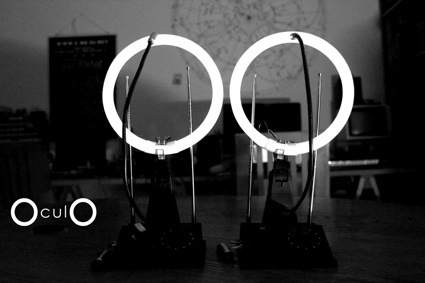 OculO
OculO
Arcangel Constantini, OculO
You use the Phonotube in performances but is it an instrument anyone could use? I suspect many people in the audience wouldn’t mind to have a go and play a bit with it? is it intuitive or is there a steep learning curve to be able to play the instrument?
I started to explore this project as an installation for stop motion animation, in the style of Emontiscope or seminscope.
Phonotube is still an experiment. I have tested different sound circuits. The intensity of the sound frequencies in its current state are meant for live performance. I included small speakers on it, thinking that it could be used by the public also as an installation, as it is simple and intuitive to use. Now, the speakers are used during the performance to Generate some EVP, Electronic Voice Phenomena using piezoelectrics directly on the speakers, performing it with OculO turn into a spectral portal.
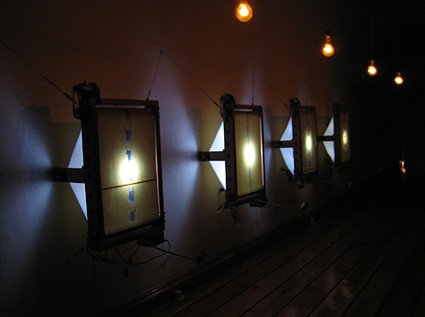 seminscope, Laboratorio de Arte Alameda Mexico, 2005
seminscope, Laboratorio de Arte Alameda Mexico, 2005
The descriptive text says that the Phonotube was “inspired by visuals experimenters as Norman Mclaren, that used the optical sound of cinema, reversing the process to experiment with it.” I looked online but didn’t find much information about McLaren’s experimentations. Could you tell us what they were about?
Norman is a pioneer of experimental sound and animation. He was artist in residence with the National film Board of Canada, he started to work directly in clear film, drawing, scratching, painting the material to produce abstract Motion films. This lead him to invade the film area dedicated to the optical sound. Fascinated by the abstract Sound Frequencies archived by different visual patterns, and how sound worked in synchronicity to the visuals, he started to produce an Impressive work using this techniques.
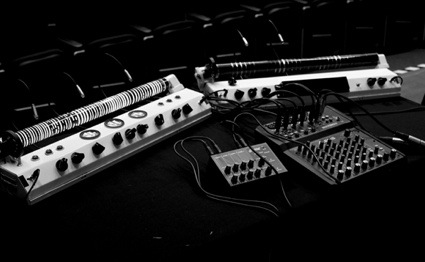 Arcangel Constantini, Phonotube
Arcangel Constantini, Phonotube
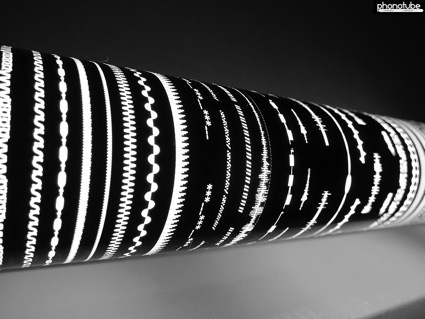 Arcangel Constantini, Phonotube
Arcangel Constantini, Phonotube
The description also said that “In the history of the invention of electronic instruments, the study of light and its behavior as a particle or wave, and its application to sound processes (…) is currently, one of the areas of scientific research with the greatest potential in human communication.” Now that sounds really interesting. Do you have examples of how the study of the behaviour lights can lead to innovative means of communication?
Most Telecommunications nowadays are based on light transmission, fiber optic cables crisscross the planet connecting the continents transmitting terabytes of data using laser technology.
There is an important research in the spectrum of visible light to transmit wireless data, instead of electromagnetic radio WiFi. The researchers are using pulsating Led light to transmit data with a huge increment in broadband velocity.
There is also the fantastic research on Quantum teleportation that tries to establish instant communication between photons separated by large distances, the record now is 143 km,
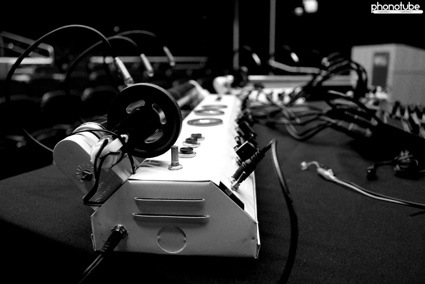 Arcangel Constantini, Phonotube
Arcangel Constantini, Phonotube
The object looks stunning. I really like its simple and striking design. How important is the visual aspect of the Phonotube in your performances?
Gracias Régine. As i mentioned, the research started as a visual project. Aesthetics become very important in its relation to sound. The tube has an the aura of a partitur. The intensity of the sound frequencies of the Low Fi oscillators are meant for live performance, the plan is to develop the project as an instrument, but as the lamps are no longer on production there is now an obsolete quality to it. The light of the lamps is the only light on stage, and for Sound & Sight performance will explore the use of analog video filming the tube.
Thanks Arcangel!
Previously, by the same artist: Nanodrizas, “flying” saucers for polluted waters, Net-art wrestling match.
Also at the Sight + Sound festival in Montreal: Crystal forming robots.
